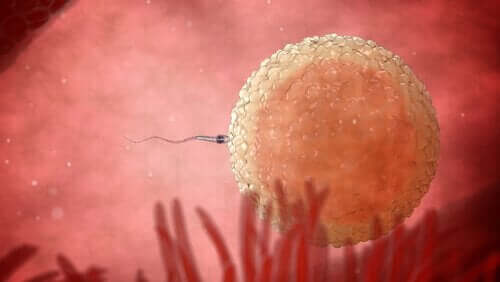How Does Embryo Implantation Take Place?

When women begin their quest to conceive a baby, it’s a good idea for them to learn about gestation and its stages. That way, they can gain knowledge about the care and attention they require throughout the process. Among the phases of embryogenesis, embryo implantation is the most important. This is because only one-third of fertilized eggs manage to make it to this point and initiate a pregnancy.
Conception can take place naturally or through assisted fertilization. In either case, implantation is a process where the embryo located within the uterus comes in contact with this organ’s cells. It then joins with the uterus in order to form the sac, which is what triggers the production of pregnancy hormones.
After the act of intercourse, a zygote forms. The zygote travels through the Fallopian tubes in order to reach the uterus. This is where the adhesion to the uterine walls takes place approximately 7-9 days after ovulation.
When this process takes place artificially, an embryo that is at least 5 days old is introduced directly. About 48 hours later, the process becomes complete with the endometrium.
When and how does embryo implantation take place?
After sexual intercourse occurs and 7 to 9 days go by after the fertilization of the egg, implantation begins. When ovulation happens, the corpus luteum starts to run out of progesterone, which maintains the structure of the lining of the uterus.

During its incrustation in the wall of the uterus, the embryo forms the means and structures to nourish itself and develop. This consists of two stages:
- The first stage is the preimplantation period. During this stage, the endometrium and egg prepare for the process. What’s more, the woman’s body starts to produce the necessary hormones, including estrogen and progesterone.
- During the second stage, the implantation stage, the adhesion becomes stronger and stronger until a rupture in the epithelial barrier occurs, followed by the invasion of the endometrium. Finally, the embryo (which is now a blastocyte) comes into contact with the mother’s blood vessels.
Differences between implantation during natural conception and implantation, following the transfer of embryos
Implantation, whether it occurs naturally or by means of assisted reproduction, takes place in the same way. The main difference lies in that, in the case of in vitro fertilization, the fertilization process takes place outside of a woman’s body. This guarantees the quality of the embryo that will later be implanted. Thanks to this treatment, specialists can know if the chances of pregnancy are high, medium, or low.
In the case of natural conception, even when fertilization of the egg takes place, there is no guarantee that implantation will follow. If there are fertilization problems that are unrelated to uterine anomalies that impede implantation, the assisted transfer of embryos can help lead to pregnancy.
Is there some test to determine the potential for implantation?
There are various tests that can determine the potential for implantation during assisted reproduction. A specialist will conduct a study of the uterus to evaluate its embryo transfer. This will verify that it possesses the proper thickness and that the hormones used are the right ones. What’s more, it rules out structures that can negatively affect the process.
In the same way, there are many studies that doctors can conduct regarding the fertilized embryo. Today, systems exist for the observation of its development by means of a video monitor. These allow doctors to evaluate whether the process is working, or has been unsuccessful. The more days that the embryos have evolved, the greater their potential for implantation.
Does embryo implantation produce symptoms?
In most cases, after the process of embryo implantation takes place, women don’t experience any symptoms. However, on occasion, women may notice a small amount of bleeding. Others may feel a bit of swelling and discomfort in their abdomen, breast pain, fatigue, or dizziness. The symptoms are very similar to those what women experience before the onset of menstruation.

It’s important to point out that each woman’s body reacts to embryo implantation in a different way. However, every woman should maintain a healthy lifestyle and stay away from situations that produce stress.
What’s more, it’s important to avoid excesses and stay away from activities that require abdominal and lumbar strength.
All cited sources were thoroughly reviewed by our team to ensure their quality, reliability, currency, and validity. The bibliography of this article was considered reliable and of academic or scientific accuracy.
- Ava. (2018). Síntomas de implantación: ¿se puede saber si se está embarazada antes de que el test dé positivo?. [online] Disponible en: https://www.avawomen.com/es/avaworld/sintomas-de-implantacion-se-puede-saber-si-se-esta-embarazada-antes-de-que-el-test-de-positivo/
- Nat, G. (2018). ¿Qué es la implantación del embrión y cuándo se produce?. [online] Reproducción Asistida ORG. Disponible en: https://www.reproduccionasistida.org/implantacion-embrionaria/#factores-relacionados-con-el-endometrio
- www.todopapas.com. (2018). ¿Cuándo se produce la implantación?. [online] Disponible en: https://www.todopapas.com/fertilidad/fertilidad-en-la-mujer/cuando-se-produce-la-implantacion-5800
This text is provided for informational purposes only and does not replace consultation with a professional. If in doubt, consult your specialist.








